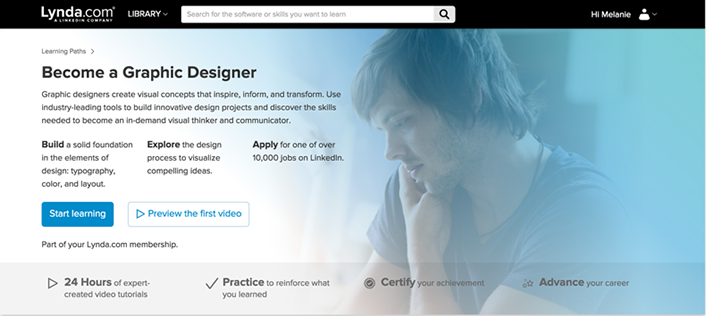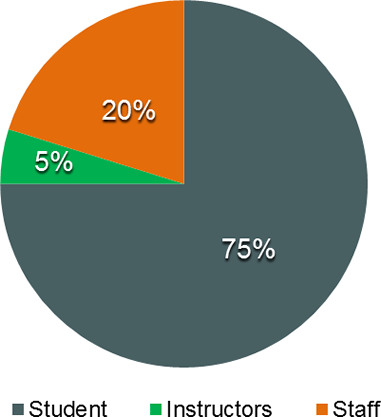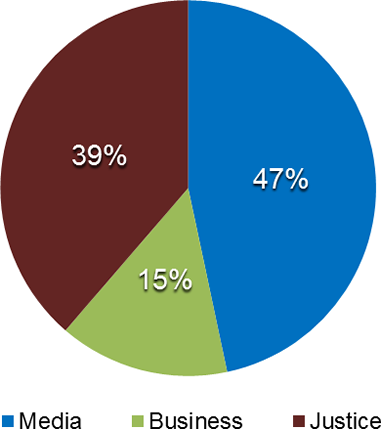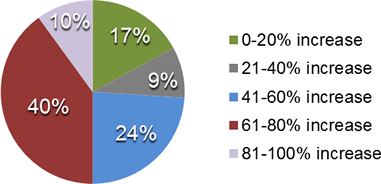Key Takeaways
- Facing license renewal of an existing e-learning platform and a campus perception that Lynda might better meet their needs, Lethbridge College ran a semester-long pilot of Lynda to gather data.
- Surveys of nonacademic staff, students, and instructors found that each group recognized clear benefits from using Lynda, although to differing degrees.
- On completion of the first project, which evaluated Lynda as a sole source, the project team then compared their existing e-learning platform to Lynda (reported in a second article in this publication).
Many academic institutions maintain a license for a 24/7, e-learning platform of instructional videos to meet on-demand learning needs. Lethbridge College, located in Alberta, Canada, has a license for Atomic Learning. A pending license renewal and a perception that Lynda might better meet our needs provided the rationale for a two-part exploratory project.
The first project, described in this article, entailed inviting students, instructors, and nonacademic staff to participate in a semester-long pilot of Lynda to explore perceptions, use, and benefits. A key goal was to gauge whether internal service providers — e.g., Human Resources, Information Technology, Curriculum Services, and Learning Services — could envision using Lynda to support their constituents. In total, 202 students, instructors, and staff participated, with 51.5 percent of participants providing feedback through a short online survey.
The second project, described in "Comparative Evaluation of Lynda and Atomic Learning," aimed to identify both platforms' strengths. We achieved this through a comparative evaluation with a focus on platform functionality, production value, and the instructional quality of lessons and courses.
The project team included myself, Andy Benoit, manager of instructional technology; Rob LaPerle, manager of customer services and operations; Corene Kozy, reference librarian; Line Gagne, human resources manager; Miranda Larson, human resource consultant; Christie Roberston, professional development manager; and Lorne Deimert, learning management systems administrator.
Using the RAIT Approach
The project methodology reflected consideration of the work done by Caroline Sinkinson, Mark Werner, and Diane Sieber, specifically their development of a Rapid Assessment of Information Technology (RAIT) approach to technology evaluation. RAIT methods include semester-long pilots, risk evaluation, identification of costs (acquisition/licensing and support), considerations for IT infrastructure, and gauging demand, all by means of data gathering and evaluation.1
A brief scan using the keywords "Lynda," "higher education," "Alberta," and/or "Canada" indicated that access to Lynda varies within postsecondary institutions. Faculty, nonacademic staff, and students have access at some institutions, whereas others limit access to faculty and nonacademic staff, and still others give access only to students. Regardless, the project team found little information about the benefits of such platforms from the viewpoint of students, instructors, and nonacademic staff.
This gap represents a missing link for postsecondary institutions that maintain such systems or those contemplating adopting alternative solutions. Equally important, the ongoing advance of nontraditional, unaccredited education providers such as Lynda warrant monitoring not only for their potential to generate disruption but also for their potential to create opportunity. Lynda was purchased by LinkedIn in April 2015 for 1.5 billion dollars. A year later, LinkedIn launched Lynda.com Learning Paths, an initiative that leverages the course catalog on Lynda, digital certifications, and the professional, social networking functionality on LinkedIn (see figure 1).2 What might this mean for higher education?

Figure 1. Lynda Learning Pathway
Methodology
We selected pilot participants to ensure representation from each of the academic centers on campus and from those areas that might integrate Lynda into the delivery of their services (e.g., Learning Services). Efforts to recruit instructors, and by extension their students, entailed communicating with deans, program chairs, and instructors. Efforts to recruit staff entailed communicating with the director of Information Technology, executive director of Human Resources, and director of Student Services. A few participants learned about the pilot by word of mouth. We told instructors and nonacademic staff the pilot would last three months and asked them to investigate Lynda as a tool to support their workplace-related learning needs and/or as a resource for their students. The instructors determined classroom integration of Lynda. All groups were informed that they would be asked to complete an online survey toward the end of the pilot.
Results
Two-hundred and two students, instructors, and staff participated in the Lynda pilot project. Collectively 386 hours of video were viewed totaling 6,497 videos with an average viewing time per login of 10 minutes. The number of logins varied across groups; see table 1.
Table 1. Number of logins per group
|
|
Mean |
Standard Deviation |
|---|---|---|
|
Students |
10.2 |
19.1 |
|
Instructors |
19 |
21.7 |
|
Nonacademic staff |
1.7 |
3.3 |
Three unique surveys were developed in consultation with the project team, one each for students, instructors, and nonacademic staff. The surveys were released online using Survey Monkey. Question types included closed and open-ended. The intent was to explore four themes: relevance, skill improvement, features, and alternate credentialing. These results form the basis of this report.
The survey response rate was 51.5 percent. Survey respondents, as shown in figure 2, included five instructors across three program areas; 21 nonacademic staff from Student Services, Information Technology Services, the Educational Enhancement Team, Accessibility Services, the Learning Café, Corporate Services, and Procurement; and 78 students across a range of media, business, and justice related courses, as shown in figure 3.

Figure 2. Respondent type

Figure 3. Course type
Theme 1: Relevance
Students, staff, and instructors were asked about the extent to which they found Lynda relevant to their learning needs. Staff (76 percent), instructors (80 percent), and students (83 percent) rated Lynda Very to Extremely relevant, as shown in figure 4. When asked how relevant Lynda was as an instructional resource for students given course outcomes, 100 percent of instructors responded Very to Extremely relevant.

Figure 4. Relevance to learning needs
Relevance was further explored by asking whether participants would recommend Lynda to a peer or colleague. Instructors (100 percent), students (86 percent), and staff (86 percent) indicated yes, as shown in figure 5.

Figure 5. Recommend to a peer or colleague
Staff who indicated "no" or maybe" in response to the question, "Would you recommend Lynda to your colleagues?" were invited to provide open-ended feedback. One participant stated, "It depends on what they need. I found it very helpful for learning software. I did find videos in my field, but they were foundational and my direct colleagues probably have that knowledge. I would share with instructors."
Lastly, relevance was explored by asking students whether they used Lynda in and out of class. When asked "Did you use Lynda.com to assist you in completing course work/assignments in class?" and "Did you use Lynda.com to assist you in completing course work/assignments out of class?" 72 percent and 67 percent, respectively, indicated "yes." Students, instructors, and nonacademic staff were also asked whether they used Lynda for personal reasons or learning (e.g., hobby); 57 percent of students, 20 percent of instructors, and 33 percent of nonacademic staff indicated "yes."
Theme 2: Skill Improvement
Non-instructional staff were asked three questions to explore the relationship between Lynda and the extent to which it positively impacted their performance. One hundred percent felt they could apply what they had learned to their work to some degree, with zero "no" responses. As a result of using Lynda, 58 percent indicated they saved less than one hour, 27 percent indicated they saved between two to five hours, and 5 percent indicated they saved between six to nine hours in their work. Based on question wording ("How much time do you estimate you saved by applying what you learned?") we assumed that the time saved covered the duration of the pilot and not, for example, per week. Lastly, 68 percent identified some type of improvement in the quality of their work as a result of using Lynda.
A similar question was asked of students: "As a result of having access to Lynda, how much of a skill increase did you experience?" The most frequent answer, encompassing 40 percent of respondents, was a perceived skill increase of 61–80 percent; see figure 6.

Figure 6. Increase in skill using Lynda
Theme 3: Features
All groups were asked to select from a list of three features those they found most beneficial, as detailed in figure 7. Review of open-ended responses also reveals the following benefits: downloadable course files, offline access, integrated notetaking, and search capabilities.

Figure 7. Beneficial features of Lynda
Theme 4: Shareable Certificates of Completion
To assess participants' perceptions of an unaccredited education provider offering certificates of completion, we asked whether they would include the "certificates of completion" on a resume, e-portfolio, or professional networking site (e.g., LinkedIn); see figure 8.

Figure 8. Would include certificate of completion
Students who indicated "no" had an opportunity to elaborate through an open-ended question. Review of feedback revealed a concern for employer perceptions, for instance, "Fear judgment from employer — because Lynda is not a college where it's accredited and trusted, where in a school they will test you and make sure it is you who is doing the testing and learning." Another respondent stated, "I don't know if I would because to me it looks to me that I'm self-taught rather than professionally taught, which is less appealing to me."
Other Results
Each group was asked which resource (s) they use or would use to support their skill development in the absence of Lynda. Students were asked, "If you did not have access to Lynda.com, what resources would you use to help in your skill development?"; nonacademic staff were asked, "If you did not have access to Lynda.com, what other online solutions would you use to support your work-related skill development?"; and instructors were asked, "What online resources do you typically use to learn new technology skills related to your work?" The most frequent resources listed for all groups is YouTube, followed by Google Search (see table 2). Other sources mentioned by students include textbooks (nine responses) and instructors (six responses). One instructor stated, "….None that are as good as Lynda. Without it, I end up Googling the topic forever trying to find good enough resources for my own learning and student learning. It is so wonderful to have access to a repository of high-quality lessons."
Table 2. Resources used other than Lynda.com
|
|
YouTube |
Google Search |
|---|---|---|
|
Staff (n = 17) |
6 |
4 |
|
Students (n = 57) |
21 |
20 |
|
Instructors (n = 5) |
3 |
3 |
All groups had an opportunity to provide open-ended feedback in response to the following question: "Is there other feedback you want to share about your participation in the Lynda.com pilot project?" Both students and instructors indicated that Lynda had a range of positive impacts on student learning.
- Student: "I really feel this is an essential tool for students to learn more outside of what we're taught in class. I would not have succeeded as well as I did in my classes without extra help from using Lynda."
- Student: "I found incredibly useful for out-of-class help when the instructor was not available. I feel this would be a huge benefit to future students especially in media programs."
- Student: "I loved having access to Lynda — the videos were easy to understand and helped me grasp programs quicker and easier."
- Instructor: "I am excited about the possibilities of my students moving to more intermediate work more quickly while using Lynda as a supplement to in-class instruction and student work."
- Instructor: "I highly recommend Lynda and students used it a lot in our program! They found it extremely beneficial for their own interests in the industry and to help with the difficult concepts in class."
- Student: "I find it really useful where it can supplement my learning in class, [for] example [when] I don't understand how the instructor is explaining it, where having another point of view explaining it helps me."
One student shared a perception on how instructors might use Lynda:
"Felt like the teacher was getting us to teach ourselves, which is nice at times, but not when it's a new program that we have zero experience with."
One nonacademic staff participant made a connection between using Lynda and maintaining his/her technology skills:
"Some skills learned through Lynda though initially being for personal learning, can also extend to enhance skills and benefit my career. Having access to a plethora of technical training is very important when you need to stay current with technology and media."
Another nonacademic participant indicated that Lynda could be used as part of the performance management review process:
"It's a nice product — I hope we go with a site license. I would direct my staff to it, to assist with achieving their goals in the PMR [Performance Management Record]."
Project Limitations
The pilot contract was finalized a few days into the start of the fall semester, which influenced the design and implementation of the Lynda project. Limited time for team consultation and project planning resulted in instructors having little advance notice of the pilot and little time to explore how best to integrate Lynda into their courses to support student learning. It is also possible that the late start and the short duration dissuaded other individuals from participating.
Discussion
Feedback from the student, instructor, and nonacademic surveys indicates that pilot participants perceived Lynda as highly relevant to them, with a majority of participants indicating they would recommend Lynda to peers or colleagues. Further, instructors viewed Lynda as relevant to students' needs based on consideration of course outcomes, with a majority of students indicating they used Lynda both in and out of class to support their course work. A notable finding from one nonacademic staff participant is that the real value of Lynda might be realized in tandem with other staff development opportunities: "Training is a good thing. Use of tools like these is even better when associated with other development opportunities like stretch assignments and feedback." Further investigation is needed, but one potential explanation for Lynda's broad relevance is the combination of instructional content packaged as short videos and the ease of access using the Internet.
A majority of nonacademic staff indicated that use of Lynda resulted in improved performance, increased efficiency, and improved quality of work. The challenge of facilitating transfer of learning to the workplace is well documented, making these findings notable given that learning occurred while "on the job" and required no additional cost (e.g., time away from work, travel costs) to the institution.
Exploration into students' perceptions with respect to integrating certifications from an unaccredited education provider into a resume, e-portfolio, or professional networking site (e.g., LinkedIn) indicate that students are inclined to do so, but not without concerns. For instance, some students mentioned the employers' possible negative perception on using an unaccredited education provider. Such findings merit consideration given the many easy-to-access and affordable learning opportunities available to students through nontraditional education providers, whether Lynda or massive open online course (MOOC) providers.
Students and nonacademic staff indicated that in the absence of a solution such as Lynda, Google Search and YouTube would be their "go to" solution, though they seemed to appreciate the value Lynda afforded. One nonacademic staff participant stated that the "Internet — it would be more time-consuming and not as comprehensive and laid out properly." Similarly, when instructors were asked, "What online resources do you typically use to learn new technology skills related to your work?" Google and YouTube were the most common responses. Anyone familiar with Google and YouTube knows that searching for and finding high-quality, meaningful results specific to a search query can be time-consuming at best, and more so if one is looking for a set of instructional resources that have been purposefully sequenced so as to guide a learner toward proficiency. One instructor stated, "None that are as good as Lynda. Without it, I end up Googling the topic forever trying to find good enough resources for my own learning and student learning. It is so wonderful to have access to a repository of high-quality lessons."
Potentially, the most exciting finding was shared through open-ended feedback. Students, in particular, noted a relationship between Lynda and gains in their learning:
- Lynda helped them learn more outside of what they were taught in class;
- was useful as an out-of-class resource when the instructor wasn't available;
- helped them learn more quickly;
- helped them learn difficult concepts; and
- served to provide another point of view, in addition to that of the instructors.
Collectively, such feedback illustrates the diverse and varied needs that learners have and the many ways they benefited from having access to high-quality, self-paced instructional content at a time and place of their choosing.
Key Findings
- Instructors and nonacademic staff have diverse learning needs that can be met in part through an on-demand, 24/7 e-learning platform. Staff (76 percent), instructors (80 percent) and students (83 percent) indicated Lynda was very to extremely relevant; over 85 percent of students and staff indicated they would recommend Lynda to a peer or colleague; 100 percent of instructors indicated that Lynda was very to extremely relevant as an instructional resource for students based on consideration for course outcomes.
- Lynda contributed to work related gains for nonacademic staff: 52 percent of nonacademic staff indicated they were able to apply what they had learned using Lynda to their work; 68 percent of nonacademic staff indicated that the quality of their work improved as a result of using Lynda; 27 percent of nonacademic staff reported a time savings of two to five hours as a result of using Lynda.
- Student and instructor open-ended feedback indicates that Lynda positively impacted student learning in a variety of ways: Lynda helped students learn more than covered in the class curriculum; was useful as an out-of-class resource when the instructor wasn't available; helped students learn more quickly; helped students learn difficult concepts; and served to provide another point of view, in addition to that of the instructors. Moreover, 40 percent of students indicated a skill increase of 41–60 percent as a result of using Lynda.
Conclusions
Despite its short duration, the Lynda pilot revealed that students, instructors and nonacademic staff have diverse learning needs and that an on-demand, 24/7 e-learning platform has a role to play in meeting such needs. As an online platform, Lynda's value resides in its searchable catalog of lessons and courses, making it possible for individuals to learn either the parts or the whole of what they need at a time and place of their choosing. Feedback from participants indicates that they found Lynda highly relevant. For staff, potential benefits include improved performance, efficiency, and quality; and for students, more efficient and deeper learning.
[See the article "Comparative Evaluation of Lynda and Atomic Learning" for the second part of this project. —Editor]
Notes
- Caroline Sinkinson, Mark J. Werner, and Diane Elizabeth Sieber, "RAIT: A Balanced Approach to Evaluating Educational Technologies," EDUCAUSE Review, June 16, 2014.
- See Kathleen Chaykowski, "LinkedIn Launches Lynda.com 'Learning Paths' in Push to Grow Education Business," Forbes, March 31, 2016; and the Lynda website on Learning Paths (2016).
Andy Benoit is manager of Instructional Technology at Lethbridge College.
© 2016 Andy Benoit. This EDUCAUSE Review article is licensed under Creative Commons BY-NC 4.0 International.
